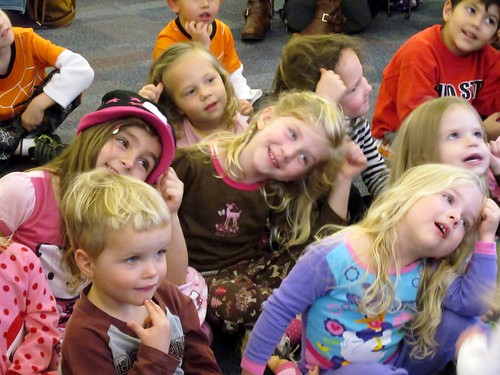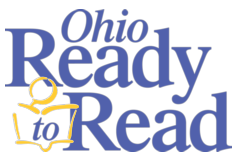Early Literacy Activities for Storytime
Here are some engaging activities that Ohio public libraries have used to support early literacy skills. Please email us activities that have worked for you or that you've observed at other libraries.

Letter Knowledge
- Play: Use modeling clay or homemade play dough and alphabet letter cookie cutters.
- Sing: Sing an alphabet song and use an alphabet chart to connect the names of the letters to their shapes. Or sign the letters to teach the children a new way letters can look.
- Talk: Talk about the shapes of letters. Use words familiar to describing shapes, such as round and straight. Point out any familiar shapes that make up (parts of) a letter - for example, an "A" could look like a triangle with two legs at the bottom.
- Talk: Talk about lines. How many lines can the children find in a letter and how do the lines connect with the other lines to make the letter?
- Write: Use alphabet rubbing plates to help children learn the shape of individual letters. Alphabet rubbing plates can be purchased from various suppliers (example from Lakeshore Learning), or they can be made with cardboard and hot glue.
Narrative Skills
- Play: Provide puppets, stuffed animals, or other toys for retelling the stories read in your program.
- Sing: Many songs and nursery rhymes tell a simple story. Sing a song or rhyme and ask questions about the characters, the sequence of events, or the children's related experiences. Repeat the song in various programs or encourage caregivers to repeat the song at home by providing a take-home song sheet, so children can learn the words and sing the song on their own.
- Talk: Share a simple and short personal story about an everyday or relatable experience. Then ask the children to share stories of their own. After a child's story, repeat the events in a sequencing form (for example, "Wow. What an exciting story. It sounds like first you went to the park, then you fell off the swing, and in the end your grandma helped you feel better by taking you home, cleaning your knee, and making your favorite snack."). Then invite another child to share. Not only will repeating each child's story help him or her understand the narrative structure, but also it will make him or her feel listened to and understood.
Phonological Awareness
- Play: Give each child an object or image of an object (for example, a toy car). At the front of the room or in a designated space, arrange objects or images of objects that rhyme with each child's item. Can the children create a rhyming pair by selecting an object/image that sounds like their own? Have the children come back together and share their rhyming pair with the group. Have everyone repeat the rhyming words before the next child's turn to share.
- Sing: Songs are excellent tools to promote phonological awareness because they slow down language and give children a chance to hear the smaller sounds in words. Choose songs with rhyming words or alliteration and be sure to talk to the children about the similar sounds. Here is an example of a song about rhyming words. Replace "bat" and "cat" with another set of rhyming words to extend the song. Encourage the children to come up with other words (real or pretend) that rhyme with the song's featured words.
- Talk: Introduce a pair of rhyming words. Have the children repeat each word after you; do this several times using different volume levels or tones of voice (you might consider having puppets join you for this part). Then ask the children to come up with other rhyming words and start the repetition process again.
- Talk: Introduce a letter from the alphabet and the sound(s) it makes. Pass out objects or images of objects that begin with that letter. Have the children tell the group what object they have. Can the children think of any other things that start with that letter and its letter sound? Does anyone's name begin with that letter?
Print Motivation
- Play: Place plush characters from storybooks (or look-alike plush animals), as well as the books themselves, in an area of the library where children and caregivers can read together. Having tangible characters to interact with may increase a child's interest in a story.
- Talk: Booktalks are designed to inspire reading and enjoyment of books, but too often we think of booktalks as activities to use exclusively with school-aged children. Why limit the power of this print-motivation tool? Why not include a booktalk of a new book or one of your favorite classics as part of a toddler or preschool program? Consider doing a character-talk or an author- and/or illustrator-talk instead. Select books, characters, and creators that excite you, talk directly to the children, and have multiple copies available to checkout.
- Talk: If we want children to love books, we need to teach children not only how to read books, but also how to talk about them. Start a book club for pre-readers and caregivers to give them the time, space, and structure needed to investigate the meaning and excitement of books.
- Write: What better way to create a connection between pre-readers and books than to help them create books of their own? Caregivers and children can create a blank book using these instructions from PBS Parents, or simply fold a sheet of paper into quarters to make a very simple blank book.
Print Awareness
- Play: Can the children find print around the room? For example, is there an exit sign, a book display, an alphabet chart, or any other signage/object that contains letters? Have you hidden any extra words around the room? You could label the things in the room (wall, chair, table, easel, etc.) to expand the activity. Talk about what the words mean and how they relate to the object they're on or the area where they are.
- Talk: Open a book upside down. Ask the children if anything is wrong with how you're reading the book. Use this as a way to introduce a "lesson" on handling a book and identifying its parts.
- Talk: Do the children know whether we read words from left to right or right to left? Choose a book with simple text, such as Barnyard Banter, and read the words on a page backward. How silly! A cow doesn't say "oom". What does it say?
- Write: Create a Matching Worksheet, in which children match a labeled image on the left to a corresponding image on the right. For example, depict five animals on the left side of the paper (animal name underneath each picture), and pictures of those animals' tails, out of order, on the right side of the paper. Or use pictures in the left column and the corresponding words in the right.
Vocabulary
- Play: Create Homemade Puzzles! Draw or print out a picture, and write the corresponding word under it. Cut the image (and word) in half for toddlers to put back together. Saying the two parts of the word aloud, followed by the whole word. This supports phonological awareness and vocabulary.
- Talk: Talking is a simple way to build vocabulary skills. Introduce a new word and talk about what it means and when/where we might say it or when/where we might hear it being said. Try introducing a new word that connects to a book you will read or an activity the children will do.
- Talk: Colors, shapes, numbers, and other concepts are all vocabulary that children must learn. Don't take for granted this important step in a child's pre-reading process. Ask about colors, shapes, and numbers whenever the occasion arises - during a program or activity or when engaging any young library user in conversation. Encourage caregivers to talk with their children about colors, shapes, and numbers wherever they are: on the bus, in the library, playing with toys, or standing in line at the grocery store.
